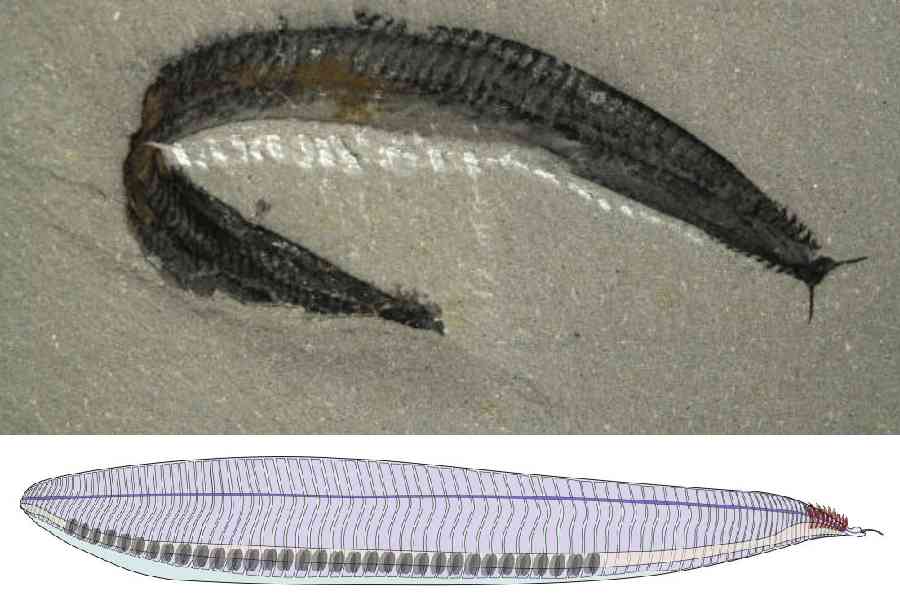Over the past 500 million years, vertebrates have evolved into various forms, from hummingbirds to elephants, bullfrogs to hammerhead sharks, to our peculiar species of upright ape. Underneath all that diversity, vertebrates share some key features.
We all have a backbone of vertebrae, for example, and a skull that houses a brain. We share these hallmarks because we all descended from a common ancestor — a fish that swam in the Cambrian seas.
But when palaeontologists look farther back in time, the story gets confusing. The fossils of ancient animals reveal a menagerie of strange creatures with puzzling bodies and unfamiliar appendages. “They just looked like freaky beasts,” said Jakob Vinther, a palaeontologist at the University of Bristol, US.
In a paper published recently, Vinther and his colleagues offered a provocative theory on how some of “those freaks” gave rise to us. Central to their argument is an inch-long, ribbon-shaped creature that lived 508 million years ago. Palaeontologists have been arguing for decades about that ancient swimmer, known as Pikaia.
Now, Vinther and his colleagues argue that previous researchers were misled by looking at Pikaia upside down.
Pikaia came to light in 1910, along with various early animal fossils that Charles Walcott, an American palaeontologist, had discovered in the Canadian Rocky Mountains. Walcott concluded that Pikaia was a polychaete, or marine worm, because of its short, fleshy appendages attached to the front of its body. Living polychaetes have similar appendages on their body for swimming or crawling.
But nearly seven decades later, Simon Conway Morris, a British palaeontologist, argued that Pikaia wasn’t a worm. Pointing to the muscles that ran along the length of its body, he proposed that it was a close relative of vertebrates. “Pikaia may not be far removed from the ancestral fish,” he wrote in 1979.
In his 1989 book Wonderful Life, Harvard evolutionary biologist Stephen Jay Gould praised it as “the first recorded member of our immediate ancestry”. But many other experts remained sceptical. They pointed to some strange features of Pikaia which were later identified by Dr Conway Morris and Jean-Bernard Caron of the University of Toronto, Canada. Most mysterious was a wide tube that ran along its back, where one might expect a nerve cord in vertebrates. Conway Morris and Caron dubbed it “the dorsal organ”, but they had no idea about its function.
“This long iconic ‘vertebrate ancestor’ remains an enigma,” wrote the French palaeontologist Philippe Janvier in 2015.
A few years later, after finding some vertebrate-like fossils in Greenland, US, Vinther decided to take a close look at Pikaia for comparison. As he inspected a high-resolution photograph on his computer, he found something odd about the dorsal organ. It had stains that Vinther recognised as sediments from the sea floor.
The only way sediments could have gotten inside Pikaia was if its dorsal organ had an opening on the outside. In vertebrates, the only organ that fits that description is the digestive tract.
So Vinther flipped the image on his screen so that the dorsal organ ran along the animal’s belly. With this change, the rest of Pikaia’s anatomy seemed to fall into place. A line across the fossil, that Conway Morris and Dr Caron had identified as a blood vessel, now appeared where a nerve cord should be.
Over the next few years, Vinther and his collaborators found more traces of a nervous system in Pikaia. They traced its new nerve cord into its head, where they saw hints of what might be a tiny brain. They also found nerves that branched out of the brain and extended into a pair of tentacles sprouting from its head.
The researchers now envision Pikaia as a free-swimming animal that searches for particles of food to eat. It apparently lacked eyes, instead using tentacles to probe its surroundings.
As for the appendages that were once thought to hang down from Pikaia’s head, the researchers now see them as extending above it. They might have been feathery outgrowths of the gills, which Pikaia used to pull oxygen out of the water.
The researchers then compared Pikaia with its new anatomy to other unusual fossils that have been suggested to be related to vertebrates. They ended up with a new — and controversial — family tree.
Giovanni Mussini, a palaeontologist at the UK’s University of Cambridge and a member of the research team, argues that Pikaia and all vertebrates evolved from truly bizarre creatures called vetulicolians. The front half of their body was a giant basket, which took in water and trapped bits of food, while the back half was a muscular tail that ended with the animal’s anus.
Vetulicolians went on to evolve a larger and stronger tail, the theory goes, while their basket shrank into a small mouth and throat, which housed gills.
More recent ancestors of vertebrates became even better swimmers, Mussini and his colleagues proposed. Unlike Pikaia, they extended their tails past their guts — a trait found in all fish, as well as land vertebrates with tails. Even later, the first proto-fish evolved cartilage cases around their brains, producing the first skulls. Later, they evolved full-blown skeletons.
“It is not so much a Big Bang, going to a fully-fledged fish,” Mussini said. “The vertebrate body plan probably had a much more protracted assembly than we thought.”
Karma Nanglu, a palaeontologist at Harvard, US, who was not involved in the new study, said that it was conceivable that Pikaia needed to be flipped. “Crazier things happen in palaeontology all the time,” he said.
NYTNS










